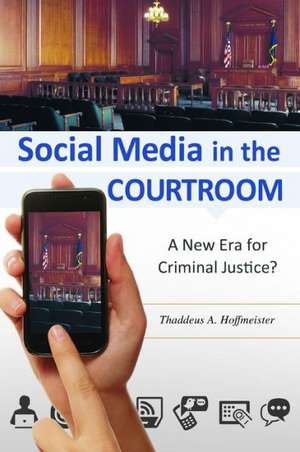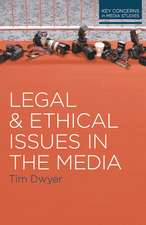Social Media in the Courtroom: A New Era for Criminal Justice?
Autor Thaddeus A. Hoffmeisteren Limba Engleză Hardback – 10 aug 2014 – vârsta până la 17 ani
Preț: 356.95 lei
Preț vechi: 482.20 lei
-26% Nou
Puncte Express: 535
Preț estimativ în valută:
68.31€ • 71.05$ • 56.39£
68.31€ • 71.05$ • 56.39£
Carte tipărită la comandă
Livrare economică 14-28 aprilie
Preluare comenzi: 021 569.72.76
Specificații
ISBN-13: 9781440830051
ISBN-10: 1440830053
Pagini: 240
Dimensiuni: 156 x 235 x 25 mm
Greutate: 0.57 kg
Editura: Bloomsbury Publishing
Colecția Praeger
Locul publicării:New York, United States
ISBN-10: 1440830053
Pagini: 240
Dimensiuni: 156 x 235 x 25 mm
Greutate: 0.57 kg
Editura: Bloomsbury Publishing
Colecția Praeger
Locul publicării:New York, United States
Caracteristici
Examines the criminal justice system from multiple perspectives in order to give fair attention to the successful uses of social media as well as the abuses
Notă biografică
Thaddeus A. Hoffmeister is law professor at the University of Dayton School of Law.
Cuprins
PrefaceSocial Media vs. Other Forms of CommunicationIntroductionSocial Media PlatformsBlogCraigslistFacebookFoursquareLinkedInMyspacePinterestRedditSecond LifeTwitterYouTubeSocial Media Defined and ClassifiedPart I Individuals1. Crime Victims2. Virtual DeputiesReluctant Virtual Deputies3. Criminal DefendantsCategory I Crimes (Relaying Information)Online Category I CrimesOffline Category I CrimesCategory II Crimes (Gathering Information)Modern Category II CrimesTraditional Category II CrimesChallenges of Preventing and Prosecuting Social Media CrimesCriminal Penalties Targeting Social Media UseSentencing EnhancementsBanMonitoringDigital Scarlet Letter4. JurorsJuror CommunicationsWhy Jurors Discuss the CaseLimiting or Controlling Juror CommunicationsPart II Law Enforcement5. Community Relations6. Prevention, Apprehension, and InvestigationPreventionApprehensionInvestigationFourth AmendmentFifth AmendmentPart III Attorneys7. Obtaining Social Media InformationIndependent ResearchSocial Media Users and ProvidersContent InformationNoncontent InformationMotion to QuashDiscovery8. Using Social MediaInside the CourtroomOutside the CourtroomInvestigating JurorsSubpoenaing a Juror's Social Media Information9. Ethical Implications of Using and Obtaining Social MediaOn the JobWitnesses and JurorsClientsFriends and the General PublicAdvertisingCommentaryOff the JobPart IV Judges10. Personal Use and EthicsGeneral PublicPrivate IndividualsIndependent Research11. Inside the CourtroomRegulating Others12. Admitting Social Media into EvidenceRelevanceAuthenticationAccess and ControlDistinctive CharacteristicsHearsayBest Evidence RuleCharacter EvidenceConclusionAppendix A: Sample Preservation Request Letter (Law Enforcement)Appendix B: Sample Preservation Request Letter (Defense Counsel)Appendix C: Subpoena Point of ContactAppendix D: Model InstructionsNotesIndex













